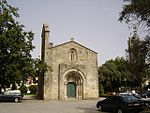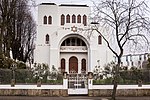Rotunda da Boavista
Squares in Porto

Rotunda da Boavista, officially known as the Praça de Mouzinho de Albuquerque, is a large roundabout in Porto, Portugal. It honours Joaquim Augusto Mouzinho de Albuquerque, a Portuguese soldier who fought in Africa during the 19th century.
Excerpt from the Wikipedia article Rotunda da Boavista (License: CC BY-SA 3.0, Authors, Images).Rotunda da Boavista
Praça Mouzinho de Albuquerque, Porto Cedofeita (Cedofeita, Santo Ildefonso, Sé, Miragaia, São Nicolau e Vitória)
Geographical coordinates (GPS) Address Nearby Places Show on map
Geographical coordinates (GPS)
| Latitude | Longitude |
|---|---|
| N 41.158132 ° | E -8.629149 ° |
Address
Heróis da Guerra Peninsular (Monumento aos Heróis da Guerra Peninsular)
Praça Mouzinho de Albuquerque
4050-322 Porto, Cedofeita (Cedofeita, Santo Ildefonso, Sé, Miragaia, São Nicolau e Vitória)
Portugal
Open on Google Maps









